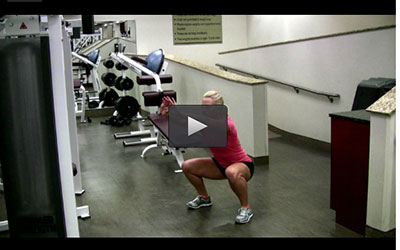Present-day theories on how to lift weights are diverse, to say the least. With so many folks saying so many things, it’s hard to know what to believe. For example, while some experts claim that it’s best to lift weights at a rapid speed, others believe moving slowly results in the greatest and fastest gains.
Except for when it comes to certain sport-specific training endeavors, I’m in the slow camp. In fact, I’ve found that moving too fast is a very common “UFO” (Unidentified Fitness Obstacle). Muscle tears and joint strains are just two examples of the many troubles that can result from rapid lifts. But progress plateaus, poor focus and poor results are by far the most common outcomes.
Slow Going
Proponents of lifting weights slowly often suggest that it’s something new – as if it’s some radical, groundbreaking thing that has just recently been revealed. The truth is that super-slow training has been making waves for the past two decades, though only in recent years has it gotten much press. Now, advocates of slow training are getting more opportunity to make their case, the most well-known being Ken Hutchins, who actually coined the term “super slow.”
Despite all the hype and “newfound” research supporting slow-movement techniques, believers in this way of training are (and may always be) on the fringe. The reasons for this are varied: Some folks are afraid they’ll look strange in the gym; others aren’t open to any idea that requires using less weight than they’re used to. Moreover, most people assume that super-slow workouts take too long (in fact, because fewer sets are required, they actually take less time). And then there’s the obvious issue: You must be more disciplined to train slow.
So is slow-mo really the way to go for the average Joe (or Joan)? The way I see it – yes.
As a rule, it works better than moving fast. Why?
Because the faster you move, the more different muscles you use, and the more different muscles you use, the less you stress the specific ones that you’re trying to work. For example, if you move quickly when performing a biceps curl, you’re likely to shrug your shoulders, bend your legs and arch your back. And the more you do, the less involved your biceps will be in the lift.
Conversely, when you move slowly, the muscles you target do more work. Not only that, but you’re less apt to suffer from tears and overstressed joints. (For more, see “The Fast and Slow of It“.)
Feeling Your Way
Working out slowly also has meditative effects. As you focus on moving slowly, you’ll be more conscious of how you feel, and paying attention to how you feel is going to improve your results.
It’s considerably harder to focus when you lift weights at a rapid speed. When your mindset is “loose” about being positioned correctly and about how movements feel, your mind is more likely to wander (which makes you more vulnerable to getting hurt). You will also tend to miss details that are critical to your success – for example, stabilizing your joints and avoiding momentum when starting a lift.
In addition, I’ve found that when people do weight- training workouts at rapid speeds, they finish them feeling fatigued, but not in the right way. For example, they’re frequently out of breath and complain about pain in their joints. Instead of feeling the muscles they’ve targeted, their whole body feels tired and sore.
Making It Count
How slowly should you move, then, to achieve your best results? Experts don’t always agree about this and you’re bound to hear different things, but I’ve found that, in general, the lifting phase should be four to six seconds long.
The lowering phase should always be about six to eight seconds long (this will vary depending on how far you have to move; for example, the greater the movement range, the longer each movement will take). Presumably, this is much slower than the two/four count you usually use when training, so expect it to feel a bit awkward at first (as well as a lot more intense). With practice and patience, however, you will adjust to the rhythm and flow, and once you do, you’ll come to appreciate why this approach is advised.
In case you’re wondering why I consider this cadence best, it’s mainly because (at least for most general applications) it has worked better than the other approaches I’ve tried. This includes lifting a weight to a count of 10 (as some super-slow proponents suggest) and also moving far more quickly, as I did for a number of years.
The key is eliminating the momentum from every lift.
For the past couple decades, I’ve kept detailed records of all my results, and have always made greater progress using a four-to-six-second count. In addition, I’ve been keeping records of hundreds of clients who’ve trained in different ways. Clearly, those who moved quickly suffered more injuries as a result and often lost ground when strained muscles and joints would prevent them from working out. Those who moved to a 10-second count would complain about being bored and rarely observed any greater success when training at such a slow pace.
The key, I think, is eliminating the momentum from every lift. You don’t need to move so slowly that you risk being bored to sleep, but you need to move slowly enough to ensure the right muscles are maximally stressed. Unless you are specifically working on explosive lifts, you also need to move slowly enough to avoid stressing your joints. If you have pain in your elbows, shoulders or knees, it’s a sign to slow down.
When lifting weights at a rapid speed, there’s more chance that muscles will tear. This happens much like a rubber band frays when it’s pulled and released very fast (pull and release it slowly, though, and you’ll see that it doesn’t fray at all). When a muscle fiber frays or tears, the result can be quite severe: Scar tissue builds, adhesions form and muscles become very tight.
Throwing It All Away
When most people train, they technically aren’t “lifting” weights. In fact, I see more weight “throwers” than I do “lifters” at the gym. Weight throwers move very quickly using the heaviest weight they can, failing to work their muscles throughout a maximum movement range. Smart weight lifters know that when they lift 10 pounds in a slow and deliberate way they are actually stressing their muscles more than when they lift 50 pounds fast. Consequently, their movements are always much more fluid and precise.
Smart weight lifters know that when they lift 10 pounds in a slow and deliberate way they are actually stressing their muscles more than when they lift 50 pounds fast.
In order to train more slowly, you will have to use less weight. Start by using 60 percent of the weight you normally use. Remember, it’s not how much you use; it’s how well you use it! If you can’t do at least six reps with perfect form, reduce the weight. If you’re able to do 10 reps with perfect form, increase the weight.
Patience is a Virtue
Slow-movement training takes discipline, but the payoff is great. Even if slower lifting doesn’t really appeal to you, you might still want to incorporate this type of approach into your periodization program and observe the results. With more than 20 years of using and studying this technique, I have all the proof I need that training this way leads to greater gains. Granted, it’s not for everyone. Many folks aren’t patient enough, and some people simply prefer how it feels to lift at a faster speed. If this describes you, my suggestion is this: Slow down as much as you can. You should find that it helps you to focus and leads you to faster and greater success.
How Can You Tell If You’re Lifting Weights Too Fast?
- You are using parts of your body that should not be involved in the lift; for example, shrugging your shoulders or arching your back when performing a curl.
- The muscle or muscles you’re targeting are not being fully stressed (i.e. when you move through a full movement range, you only feel stress at some points).
- You’re putting more stress on your joints than you are on the muscles you’re trying to work.
- You can hear weights rattling or clanging (or hear the moving parts on a machine).
- You’re consistently holding your breath, feeling stress on your shoulders or arching your back.
- You’re losing your balance or finding it hard to stabilize muscles and joints (for example, you’re lifting your elbows when doing a seated curl on a machine).
- Your movements are not always fluid and performed with full control.
This article originally appeared as “Speed Limit” in the March 2004 issue of Experience Life.




This Post Has 0 Comments